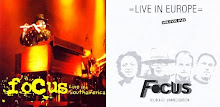Title: Hocus Pocus
Main Album: Moving Waves (Focus 2 in Holland) (Also a single in edited form in 1971, 1972, 1973 and 1977)
Track number: 1
Genre: Progressive Rock Instrumental
Studio: Sound Techniques Studio, 46a Old Church Street, Chelsea, London SW3 (also Morgan Studios, London)
Length: 6' 40”
Composer: Jan Akkerman, Thijs van Leer
Musicians: Jan Akkerman – Electric guitars (Gibson Les Paul Customs), Bass; Thijs van Leer – Hammond organ, Yodelling, Whistles, Shouts, Claps, Flute, Harmonium; Cyriel Havermans - Bass; Pierre van der Linden - Drums
Producer: Mike Vernon
Engineer: Jerry Boys
Label: LP - Imperial, Blue Horizon CD – EMI Bovema, IRS, Red Bullet
Date of recording/release: April 13 - May 14 1971/October 1971. CD - 1988, 1993, 2001
Length: 6' 40”
Composer: Jan Akkerman, Thijs van Leer
Musicians: Jan Akkerman – Electric guitars (Gibson Les Paul Customs), Bass; Thijs van Leer – Hammond organ, Yodelling, Whistles, Shouts, Claps, Flute, Harmonium; Cyriel Havermans - Bass; Pierre van der Linden - Drums
Producer: Mike Vernon
Engineer: Jerry Boys
Label: LP - Imperial, Blue Horizon CD – EMI Bovema, IRS, Red Bullet
Date of recording/release: April 13 - May 14 1971/October 1971. CD - 1988, 1993, 2001
Alternative versions: Among the many other versions of this piece are the single edit mentioned above, the US single version, a version by van Leer (Nice to have met you) and several live versions by Focus and Akkerman. There are also a number of covers by various bands. In 2010 a new mix (the Darius Syrossian & Nyra Mix) appeared in connection with a Nike advert for the 2010 football world cup. A further lease of fame came in 2017 with its use in the film Baby Driver.
Notes: When edited, this track was the single that later propelled Focus to fame. It was first seen on mainstream television in the UK on The Old Grey Whistle Test in November 1972. For the next 10 days Polydor had to devote its entire vinyl pressing plant to servicing the unexpected demand for Moving Waves.
Analysis of the self-mocking track reveals that it can be split into 15 constituent parts, beginning and ending with the full band but alternating with van Leer and his tricks all the way. We begin with electric guitars (first a single strummed guitar [00:00-00:09] with a single note from elsewhere at 00:05 before more guitars join in with the riff after first the drums then the whole band come in for the first run through of the riff (00:00-00:47). At 00:48 we have break 1 - the drums come in alone, followed by van Leer's yodel and a sort of scream. The band then come back in with the main theme (01:14-01:39) to be followed by break 2 - a repeat of the drums, yodel, scream sequence (1:40-02:04). The band come in again (02:05-02:32) but at the third break van Leer uses a strange unintelligible gnome-like gibberish (02:33-02:53). The order established, the band alternate with van Leer to the end. The yodel and scream come another twice. Between these breaks two other alternatives are used – break 4, a breathy flute (04:10-04:30) then break 5 - whistles, claps and a studio harmonium (04:56-05:12). Each time the band comes in, Akkerman's guitar grows wilder and more frenetic. The final yodel break (break 7) is at 05:43-06:03 and the band finale, introduced by screams or shouts, is at 06:04-06:40. The band end in unison. There is also an unconnected 1930s jazz number with the same title.
Notes: When edited, this track was the single that later propelled Focus to fame. It was first seen on mainstream television in the UK on The Old Grey Whistle Test in November 1972. For the next 10 days Polydor had to devote its entire vinyl pressing plant to servicing the unexpected demand for Moving Waves.
Analysis of the self-mocking track reveals that it can be split into 15 constituent parts, beginning and ending with the full band but alternating with van Leer and his tricks all the way. We begin with electric guitars (first a single strummed guitar [00:00-00:09] with a single note from elsewhere at 00:05 before more guitars join in with the riff after first the drums then the whole band come in for the first run through of the riff (00:00-00:47). At 00:48 we have break 1 - the drums come in alone, followed by van Leer's yodel and a sort of scream. The band then come back in with the main theme (01:14-01:39) to be followed by break 2 - a repeat of the drums, yodel, scream sequence (1:40-02:04). The band come in again (02:05-02:32) but at the third break van Leer uses a strange unintelligible gnome-like gibberish (02:33-02:53). The order established, the band alternate with van Leer to the end. The yodel and scream come another twice. Between these breaks two other alternatives are used – break 4, a breathy flute (04:10-04:30) then break 5 - whistles, claps and a studio harmonium (04:56-05:12). Each time the band comes in, Akkerman's guitar grows wilder and more frenetic. The final yodel break (break 7) is at 05:43-06:03 and the band finale, introduced by screams or shouts, is at 06:04-06:40. The band end in unison. There is also an unconnected 1930s jazz number with the same title.
A note on Hocus Pocus (from Wikipedia)
Van Leer has said that the track has everything to do with rhyming with Focus and nothing to do with magic, however
Van Leer has said that the track has everything to do with rhyming with Focus and nothing to do with magic, however
Hocus Pocus is a generic term used by magicians, usually the magic words spoken when bringing about some sort of change. It was once a common term for a magician, juggler or other similar entertainer. In British English its most prevalent modern meaning is contrived nonsense, as in, "It was all a load of hocus pocus". The origins of the term remain obscure. Some believe it originates from a parody of the Roman Catholic liturgy of the eucharist, which contains the phrase Hoc est enim corpus meus (This is my body). This explanation goes back to speculations by Anglican Prelate John Tillotson who wrote (1694) "In all probability those common juggling words of hocus pocus are nothing else but a corruption of hoc est corpus, by way of ridiculous imitation of the priests of the Church of Rome in their trick of Transubstantiation." Others believe that it is an appeal to the Norse folklore magician Ochus Bochus. The Welsh hwca pwca (a "goblin's trick" or hoax) could also be the source. It may simply be imitation Latin with no meaning, made up to impress people: "I will speak of one man ... that went about in King James his time ... who called himself, The Kings Majesties most excellent Hocus Pocus, and so was he called, because that at the playing of every Trick, he used to say, Hocus pocus, tontus talontus, vade celeriter jubeo, a dark composure of words, to blinde the eyes of the beholders, to make his Trick pass the more currently without discovery, because when the eye and the ear of the beholder are both earnestly busied, the Trick is not so easily discovered, nor the Imposture discerned." Thomas Ady, A Candle in the Dark, 1656.





















No comments:
Post a Comment